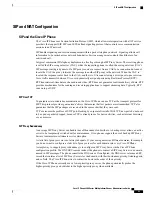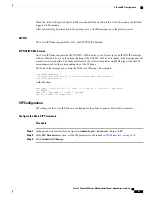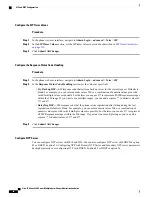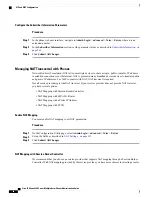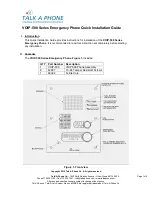
Management Address TLV
The TLV identifies an address associated with the local LLDP agent (that may be used to reach higher layer
entities) to assist discovery by network management. The TLV allows the inclusion of both the system interface
number and an object identifier (OID) that are associated with this management address, if either or both are
known.
•
TLV information string length
—
This field contains the length (in octets) of all the fields in the TLV
information string.
•
Management address string length
—
This field contains the length (in octets) of the management address
s management address fields.
System Description TLV
The TLV allows the network management to advertise the system description.
•
TLV information string length
—
This field indicates the exact length (in octets) of the system description.
•
System description
—
This field contains an alphanumeric string that is the textual description of the
network entity. The system description includes the full name and version identification of the system
hardware type, software operating system, and networking software. If implementations support IETF
RFC 3418, the sysDescr object should be used for this field.
IEEE 802.3 MAC/PHY Configuration/Status TLV
The TLV is not for autonegotiation, but for troubleshooting purposes. For the incoming LLDPDU, the TLV
is ignored and not validated. For the outgoing LLDPDU, for the TLV, the octet value autonegotiation
support/status should be:
•
Bit 0
—
Set to 1 to indicate that the autonegotiation support feature is supported.
•
Bit 1
—
Set to 1 to indicate that autonegotiation status is enabled.
•
Bit 2-7
—
Set to 0.
The bit values for the 2 octets PMD autonegotiation advertised capability field should be set to:
•
Bit 13
—
10BASE-T half duplex mode
•
Bit 14
—
10BASE-T full duplex mode
•
Bit 11
—
100BASE-TX half duplex mode
•
Bit 10
—
100BASE-TX full duplex mode
•
Bit 15
—
Unknown
Bit 10, 11, 13 and 14 should be set.
The value for 2 octets operational MAU type should be set to reflect the real operational MAU type:
•
16
—
100BASE-TX full duplex
•
15
—
100BASE-TX half duplex
Cisco IP Phone 8800 Series Multiplatform Phones Administration Guide
49
VLAN Settings
Summary of Contents for 8851
Page 23: ...P A R T I About the Cisco IP Phone Technical Details page 9 Cisco IP Phone Hardware page 21 ...
Page 24: ......
Page 36: ...Cisco IP Phone 8800 Series Multiplatform Phones Administration Guide 20 USB Port Information ...
Page 48: ......
Page 98: ......
Page 136: ......
Page 168: ...Cisco IP Phone 8800 Series Multiplatform Phones Administration Guide 152 XML Services ...
Page 204: ...Cisco IP Phone 8800 Series Multiplatform Phones Administration Guide 188 Capture Packets ...
Page 210: ......



















